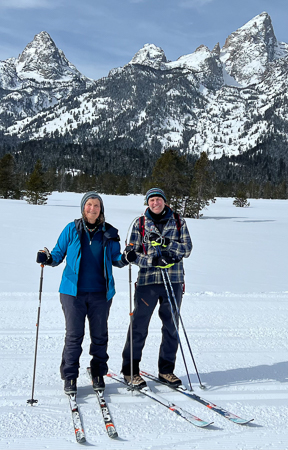March 2022 Newsletter: Preserving Democracy & the Health of our Planet
Hello!
 Arlene and Erik from Keen— a leader in PFAS-free shoes I am cross country skiing on the snowy slopes of Jackson Hole, Wyoming following a productive trip to Washington, D.C. where I enjoyed spending time with my daughter. Annalise will be joining me at the annual Berkeley Himalayan Fair on May 21, 2022 and you are invited too. During walking meetings on the mall in DC while passing the Capitol, my thoughts turned to the importance of maintaining democracy compared to autocracy, both in the Ukraine and here in the US. Our hearts go out to the brave people of Ukraine fighting to keep their freedom and democracy. I believe that preserving our own democracy is critical for our Institute’s toxics work and indeed the well-being of our planet. Encouraging voter registration and voting is so important. I’m supporting non-partisan non-profit voting organizations such as Voter Participation Center and Movement Voter Fund right now when my contributions will be the most helpful and suggest you might consider doing the same.  Preserve our democracy In DC I also learned about the CDC’s One Health Office, which recognizes the interconnection between people animals, plants, and our shared environment. This aligns with our Institute’s work to reduce the use of toxic chemicals that end up in people, pets, wildlife, water, crops, and more. A memorable example of One Health’s work is its collaboration with the Georgia Aquarium investigating the spread of COVID-19 to otters. Thanks to the Safe Cosmetics Campaign, the National Healthy Nail Salon Alliance, and others, many nail polish companies and salons have switched to healthier products. However, a new study from our colleague Dr. Miriam Diamond found that exposure to some toxic phthalates and notably the chlorinated tris-flame retardants TCEP and TCPP was unexpectedly high among nail technicians at some discount nail salons. Levels of these two chlorinated organophosphate esters (that are used as flame retardants) were up to 75 times higher than typical home exposures. This is a troubling environmental injustice. The source of the chlorinated flame retardant chemicals is unknown and a mystery. Please get in touch if you have any ideas about why the chlorinated tris levels could be so high in nail salons. On the other hand, levels of the harmful phthalate DEHP, that is listed on Canada’s Cosmetic Hotlist, were similar to levels in homes. This finding suggests that the Hotlist regulation is having an impact in reducing harm from DEHP. While walking in Washington DC, congressional staff members and I discussed such ideas for reducing chemical harm. And while skiing in the Tetons, Erik Burbank from Keen and I talked about inspiring outdoor manufacturers to remove toxics from their products. I hope to share progress on these efforts with you soon. With optimism for preserving democracy and health, Arlene |
Annual Berkeley Himalayan Fair, May 21 & 21, 2022Please join me at this year’s annual Himalayan Fair—happily back following a pandemic hiatus. You can enjoy the food, music, dance, crafts and arts of the Himalayas at the Fair, which will be held in Live Oak Park, 1300 Shattuck Avenue in North Berkeley, California on Saturday and Sunday May 21 and 22. The fair’s profits go directly to the Himalayan regions as donations to orphanages, clinics, schools, village water supplies, and other Himalayan charities. My daughter Annalise will be at the Fair on Sunday visiting from DC. Please stop by our booth under the big tree northeast of the stage to enjoy the Himalayan dance and other entertainment. Contact me if you’d like to volunteer at our booth or contact SapanaSharma@gmail.com to volunteer to help out with the fair. I describe starting the Fair after returning from the Great Himalayan Traverse in my memoir Breaking Trail. More information about the Himalayan Fair is here. |
Supporting DemocracyMy recent outdoor DC meetings with hard working and thoughtful staff members in the Senate and House, reminded me of the importance of preserving our democratic institutions. Registering, empowering, and mobilizing voters will contribute to maintaining our democracy during these perilous times. For maximum impact, right NOW is the best time to provide your support. Some effective organizations to consider: The Voter Participation Center is a non-profit, non-partisan organization that has helped more than 5.7 million people of color, young people and women register and cast ballots since 2003. Click here to contribute online or here to donate with a check. Movement Voter Fund supports local grassroots organizations that promote voter registration in disenfranchised and diverse communities. We also need to make sure that votes will be counted and will matter. Two tax deductible organizations leading legal challenges against voter suppression are: NAACP Legal Defense and Educational Fund A useful source of information is Letters from an American, a free daily newsletter from historian Heather Cox Richardson. Her messages provide insight into current events such as Biden’s State of the Union address and help us understand the present events like the war in Ukraine with perspectives from the past. Also, please do let me know if you’d like to hear from me a few times a year with other suggestions for maintaining our democracy. And I’d be interested in your additional suggestions. |
Flame Retardants in Tents?by Lydia Jahl Did you know that California’s tent flammability regulations have not been updated since 1975? Many decades ago, some tents were made of flammable waxed canvas, resulting in some serious tent fires. But now, most backpacking and camping tents are made of lightweight synthetic materials that are less flammable, so that tent fires resulting in injury are vanishingly rare. Unfortunately, outdated tent flammability regulations still result in unnecessary and harmful flame retardants being added to tents across North America – including children’s play tents. The chemicals can migrate out of tent materials and expose campers and children to potentially increased risks of cancer, neurological, and reproductive harm, without increasing fire safety. In fact, tent materials can have the same harmful flame retardant – chlorinated tris – that was removed from baby pajamas in the 1970s and that we will be testing for in cars. Scientific studies in the Stapleton lab at Duke in 2014 and 2016 found that skin exposure to flame retardants occurs from handling camping tents and that inhalation exposure will likely occur while inside a tent. This research found that levels of chlorinated tris measured on hand wipes were 29 times higher post-tent setup compared to pre-setup. The chemical was also detected in the air inside of treated tents. The good news is that tent retailers, manufacturers, and the Outdoor Industry Association are working to change standards and remove the need for flame retardants in camping tents. They have developed an updated standard that can be met without flame retardant chemicals. However, the support of California’s fire marshal or changes to state legislation are needed before this improved standard can be implemented. Click here to learn more from a guest blog by Neal Cohen, a product safety attorney who works with tent manufacturers and retailers on sustainability. |
Why Such High Levels of PFAS in New Zealand Dolphins?by Carol Kwiatkowski Why would PFAS levels in New Zealand dolphins–where no PFAS are manufactured–be as high as in more industrialized countries that do manufacture PFAS and products containing it? Researchers studied a dozen dolphins stranded on New Zealand’s coast. They identified ten different PFAS with levels
high enough to analyze. The researchers were surprised to find high levels of PFAS in all 12 dolphins. They hypothesized sources of PFAS to be the use of firefighting foams and other PFAS-containing products in New Zealand, as well as global distribution. Previous research in dolphins and other marine mammals, noted in this study, demonstrate that PFAS can disrupt the endocrine, immune, and neurological systems. This raises concern for the future of dolphins everywhere, including in New Zealand where these gentle intelligent creatures are revered. This study also shows that PFAS may be found in many places, and we don’t know where until we look. We can’t clean up entire oceans of PFAS. Only by turning off the tap of PFAS-laden products will we begin to fix the problem. For more information, hear attorney Rob Bilott, Arlene Blum, and scientist Graham Peaslee’s webinar to educate journalists and others in New Zealand about PFAS (or view the 3-minute highlight reel). |
Mist Connection: Concerning Levels of PFAS in Anti-Fogging Productsby Jonas LaPier PFAS were recently found in sprays and cloths used to prevent eyeglasses from fogging, products that are especially useful with frequent mask-wearing nowadays. Our colleagues in the Stapleton lab at Duke University tested nine popular anti-fogging products and found PFAS in all of them. Moreover, the amount of PFAS in most of these products The authors calculate that if you assume 1% of these solutions enters the body, through inhalation or through the skin, your exposure would be 14 to 500 times greater than drinking 1 liter of water contaminated at the EPA’s health advisory level. In other words, they are full of PFAS. “It’s disturbing to think that products people have been using on a daily basis to help keep themselves safe during the COVID pandemic may be exposing them to a different risk,” said Heather Stapleton, the senior author of the study. Researchers have not previously studied anti-fogging products and only a few were tested in this first study, so not much is known about the extent of PFAS use in other products. At this point we are not aware of PFAS-free alternatives, but we will post them on our PFAS-Free page as we learn more. For now, you can read this article for tips on preventing foggy glasses syndrome. You may also be interested in watching this short video or reading the original paper for more detailed information. |
CalendarMarch 24, 2022 (virtual): Expert speakers from around the world will present the latest regulatory and scientific May 21 & 22, 2022: Enjoy the food, music, dance, crafts and arts of the Himalayas. Profits to Himalayan
|




